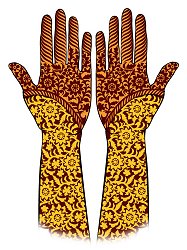 The Warrior's Wife Calls the Henna Artist for Victory or Suttee Catherine Cartwright-Jones c 2004 Kent State University A poet from Rajasthan, Suraya Malla Misran,
wrote a couplet about a woman whose warrior husband was about to go
into battle. If her husband died in the conflict, her family
would insist that she commit suttee. She
would comply, or she would spend the rest of her life without support,
impoverished and alone. A henna artist, the Nai woman*, had come to her house to henna her
feet and hands with henna. The woman said, "No, not today.
My husband is going into battle, and may die. Come back tomorrow,
in case I need to henna for suttee." Nayan, do not deck my feet today, This shows that henna accompanied suttee,
the suicide of a living wife upon her dead husband's funeral pyre. Another Indian poet, Sekhavat, wrote about a woman whose husband was also going into battle, but who did not simply wait for news from the battlefield. He would return either victorious or dead. She would either join the celebration or she would prepare to throw herself on his funeral pyre. She asked the henna artist to henna her feet and hands for either possibility. "Nayan, you decorate me with rich colored
mehndi right
now, *The Nai, or Nayan, caste was the caste of people who were barbers and henna artists. They were low caste, because they touched people's hair and feet. A Brahmin would wash himself after being shaved by a Nai, to remove the pollution from contact with them. Upper caste people would not take water from a Nai's hands.  Pattern from Alex Morgan's book, "Warrior" patterns adapted from the weapons of war Click on image for larger view and more of her patterns! Reference: Return to The Encyclopedia of Henna Index Return to the War Index Can't find what you're looking for? Try: The Henna Page Main Index http://www.hennapage.com/henna/mainindex.html *"Henna,
the
Joyous Body Art"
the Encyclopedia of Henna Catherine Cartwright-Jones c 2000 registered with the US Library of Congress TXu 952-968 |
